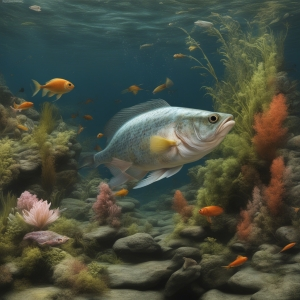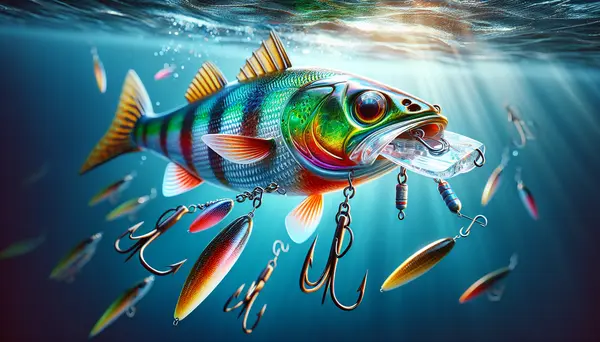Table of Contents:
Introduction: Unravelling the Mystery of Fish Senses
When it comes to fishing, there's a lot more science involved than meets the eye. One of these little-known aspects is the unique sensory abilities of fish and how they detect lures. Understanding this facet of fishing can enhance your success rate and make your angling adventures more fruitful. This article aims to demystify the science of fish senses and provide a comprehensive guide on how fish detect lures. Whether you're a novice angler or a seasoned veteran, gaining insights into this fascinating subject will undoubtedly enhance your fishing expertise.
So, sit back, and let's dive into the underwater world of fish senses!
The Intricate Workings of Fish Senses
Fish, like other aquatic creatures, have adapted to rely on unique sets of senses for survival and navigation in their underwater environment. They possess an extraordinary ability to interpret changes in pressure, light, and electromagnetic fields. This sensory perception allows them to detect food, avoid predators, and navigate across vast aquatic landscapes. The cornerstone of a fish's sensory system comprises of sight, smell, taste, and the often overlooked, lateral line system.
Fish vision, contrary to popular belief, can be quite sharp, and they sometimes respond better to specific colors. Smell plays a vital role in locating food and sensing danger. The taste, considerably more developed than humans, aids in distinguishing between edible and harmful substances. Lastly, the lateral line, a sensory organ seldom known outside aquatic biology, captures water movements and vibration in their surroundings. This sophisticated sensorial network is what helps fish spot lures in their vicinity.
Fish Senses Versus Lure Detection
| Pros | Cons |
|---|---|
| Fish can detect lures even in low light using their motion detectors and lateral line. | Some fish may become 'lure shy' and stop responding to certain types of lures. |
| The vibration and noise of a lure can attract fish from a distance. | Fish can also be frightened away by lures that are too noisy or vibrate too much. |
| Understanding what fish can see, hear, and feel can help in designing more effective lures. | There is still a lot we don't understand about fish senses, so it's sometimes trial and error to find the best lure. |
The Role of Vision in Fish Attraction

Fish rely heavily on vision to find food - and that includes your bait. The clarity of the water plays a big part in a fish's ability to see your lure. In clear water, fish can see shades of red and orange the best. But in deeper or murkier waters, they tend to respond more to shades of blue or green. Varying your lure's colours accordingly can increase your chances of a successful catch.
It's also important to know that fish are attracted to movements. As such, lures that ripple the water or give off a mimicking motion of a wounded prey are likely to get the attention of the fish. The movement of the lure taps into the fish's natural instinct to hunt, making your bait an irresistible target.
In summary, visibility and motion are key when it comes to catching a fish's attention with a lure. Depending on the conditions, adjusting the colour and movement of your bait can significantly boost your success rate.
Fish Hearing and Vibration Detection
Fish have a unique sense of hearing. Unlike humans, they use inner ears only for hearing. The most stunning aspect of fish hearing is their ability to detect sounds within and above their aquatic environment. They pick up on quiet noises and sharp dips in frequency - often the sounds of a tasty treat nearby.
Besides hearing, fish also detect vibrations in the water. They use a specialized network of nerves called the lateral line. The lateral line is sort of like an extended ear and nose, capturing movement, vibration, and pressure changes. If your lure moves in the water, a fish can sense its vibrations using its lateral line, even in pitch darkness or murky water.
In conclusion, sounds and vibrations play a crucial role when it comes to fishing. Therefore, having a basic understanding of this can assist in selecting the perfect lure hence, potentially increasing your catch rate.
Smell and Taste: A Key Factor in Fishing Success

Did you know fish have a keen sense of smell and taste? They can use these senses to pick up chemical signals in the water. These signals may come from potential food, other fish, or even danger.
Scent can play a crucial role in successful fishing. Many fish are attracted to certain scents, which they associate with food. It’s why seasoned anglers often use scented or flavor-enhanced baits to catch more fish. By using a lure infused with smells that fish find appealing, you are likely to attract more fish.
Along with smell, fish also have a sublime sense of taste. They utilize their taste receptors, located all over their body, to decide if a potential meal is worth eating. This means that if your lure doesn’t taste right, a fish might spit it out before you have a chance to set the hook.
In conclusion, when considering the right lure, paying attention to scent and taste could boost your catch rate. Try to select lures that not only look appealing but also smell and taste like real food to fish.
The Lateral Line System: A Unique Sense
Capturing the wonders of the fish world, we find a unique sensory system known as the lateral line system. Existing only in aquatic life forms, this system enables fish to perceive their environment in extraordinary ways.
The lateral line system runs along the fish's body, from its head to its tail. It is made up of a series of small, sensitive patches of hair-like structures. These structures detect changes in water pressure and movement. Imagine it like a radar or sonar system that picks up subtle shifts in the water around the fish.
This is how fish feel the presence of objects or other creatures, even at a distance or in low visibility conditions. If a predator or prey is nearing, the fish can sense its approach through the ripples it creates in the water. The lateral line system gives the fish precious moments to either prepare for attack or make a swift exit.
Understanding this unique sense can greatly influence your approach to luring and baiting. Lures which effectively mimic the vibrations and water movements of natural prey can significantly stimulate the lateral line, increasing the chance for a big catch.
So, next time you cast your line, remember that fishing success often hinges on appealing to this lesser known yet crucial fish sense: the lateral line.
Fish Sensitivity to Electricity: An Underwater Superpower

Another amazing ability that fish have is their sensitivity to electricity. This might sound like something out of a comic book, but it's entirely factual. Many types of fish can sense electrical fields in the water. It's a skill they use to locate prey and avoid danger.
Some types of fish, like rays and sharks, can even sense the faint electrical fields produced by other animals' muscles and nerves. This ability is so keen that a shark can detect a fish hiding under sand based on its electrical field alone. Other fishes, like the knifefish, can produce their own electrical field, which they use to navigate and communicate in dark or muddy waters.
When it comes to fishing, understanding this electrical sensitivity can be incredibly useful. Some modern lures even include small electrical devices to mimic the fields produced by prey animals. By tapping into this underutilized sensory system, such lures can attract fish more effectively than traditional ones.
In conclusion, the understanding and usage of electricity in the world of fishing can give you the upper hand. It's like speaking the secret language of fish, and the fish tend to listen. This knowledge is part of the fascinating world of fish senses and can up your angling game significantly.
Applying Fish Senses to Improve Your Fishing
Knowing how fish sense lures is the first step to improving your fishing. Let's explore how understanding fish senses can give you the upper hand in angling.
You can choose lures that appeal to multiple fish senses at once. By doing this, you increase the chances of fish noticing your bait. For instance, a bright, scented lure that creates vibrations as it moves through the water would likely attract more fish than a simple, unscented one.
Understanding the fishes' sensory preferences allows you to tailor your fishing strategy to different species and environments. If you know that a certain species of fish has a keen sense of smell, using scented bait could be advantageous. Similarly, knowing that some fish can see better than others can guide you to select more visually appealing lures.
Light conditions also play a role in how fish see lures, so consider the time of day when fishing. Daylight could favor colorful lures, while natural or more muted hues may be effective in low light conditions. Remember, what might be invisible to you under less light might be brightly lit up in a fish's eye!
Lastly, remember to be patient. Fishing is a game of waiting and observing. Watch the water conditions, adjust your lures as needed, and with a little patience, you are bound to strike gold!
Understanding fish senses might seem like an overwhelming science lesson at first, but with practice and keen observation, it becomes an invaluable tool for any angler. So gear up, hit the waters, and wait for that catch of the day!
Conclusion: Engaging Fish Senses to Enhance Angling Experience
Getting to know the complex senses of fish might seem like a daunting task at first. However, recognising how a fish's vision, hearing, smell, taste and lateral line system work can revolutionise your angling experience. By understanding what fish can see, hear, smell, and taste, we can tailor our lures to meet their sensory needs. You don't have to be an expert ichthyologist to apply these fundamentals. It's all about choosing the right lures with vibrant colours, high frequencies, enticing scents, and tasty flavours. Doing so can draw fish in from afar and convince them to take a bite.
A reminder when you're on your next fishing trip: the joy of fishing isn't solely in the catch, but also in understanding and becoming one with the aquatic world. The more we comprehend the senses of fish, the closer we are to becoming environmental stewards who fish responsibly and sustainably for generations to come.
FAQ: Unraveling Fishy Senses: How Fish Detect Bait
How do fish perceive their environment?
Fish sense their surroundings using a variety of sensory organs, including eyes, ears, smell and taste receptors, lateral lines, and electroreceptors.
How do fish detect lures?
Fish detect lures mostly with their eyes and lateral lines. Lateral lines allow them to sense movement and vibrations in the water.
Can fish smell and taste bait?
Yes, fish can detect chemicals released by lures in the water and can taste bait. Their smell and taste senses play a crucial role in finding food.
Do fish senses vary between species?
Yes, sensory capabilities can differ greatly between species. Some fish can detect electric fields, while others have excellent vision or highly developed smell and taste senses.
How can understanding fish senses improve fishing?
Understanding how fish detect lures can help in choosing the right bait and technique to catch a particular species. It can also aid in conservation efforts.







